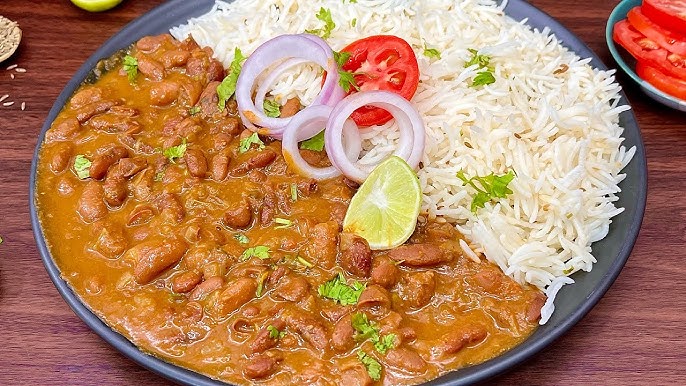Rajma Recipe: Rajma, or red kidney beans, is more than just a staple legume—it’s a comfort food and a cultural favorite in India. Imagine a rich, hearty, and aromatic curry that warms you up from the inside. That’s Rajma. These kidney-shaped beans are soaked, pressure-cooked, and simmered in a spiced tomato-onion gravy that turns into a velvety, flavorful dish best paired with hot steamed rice.
Though Rajma originated from Mexico and Central America, it found its spiritual home in Indian kitchens, especially in North India. In states like Punjab, Rajma Chawal (Rajma with rice) is a weekend ritual. It’s not just food—it’s nostalgia served in a bowl.
People love Rajma for its rich texture, bold spices, and the ability to soak up flavors beautifully. It doesn’t matter whether you’re vegetarian or a hardcore meat lover; Rajma has a way of winning hearts. The way the soft beans melt into the thick gravy—pure magic.
Popularity of Rajma in Indian Cuisine
Rajma is deeply rooted in the culinary traditions of India, particularly North India. Punjabi cuisine, known for its robust flavors, has made Rajma famous across the country and now, globally.
Why is it so loved? Because it’s soul food. It’s one of those dishes that doesn’t need fancy ingredients or complex techniques—just patience and the right balance of spices. It is often cooked during festivals, family gatherings, and lazy Sundays when the family sits together around a hot plate of Rajma Chawal.
In urban households, it’s a go-to comfort meal after a long day. In dhabas (roadside eateries), spicy Rajma Masala is a bestseller. Even health-conscious millennials are rediscovering Rajma for its high protein and fiber content.
Nutritional Benefits of Rajma
Health Benefits of Kidney Beans
Kidney beans aren’t just tasty—they’re incredibly nutritious. A single cup of cooked Rajma packs in about 15 grams of protein, making it an excellent source of plant-based protein, especially for vegetarians and vegans. It’s rich in dietary fiber which aids digestion and promotes a feeling of fullness.
But that’s not all. Rajma is a great source of:
- Iron: Helps in improving hemoglobin levels.
- Magnesium: Supports muscle and nerve function.
- Potassium: Good for heart health.
- Folate: Essential for cell growth and DNA formation.
Additionally, kidney beans have a low glycemic index, making them a diabetic-friendly food. They also contain antioxidants that help fight inflammation and chronic diseases.
Why Rajma is a Great Vegetarian Protein Option
In a country where a large population relies on vegetarian meals, Rajma is a star ingredient. Unlike some legumes that may lack one or more essential amino acids, Rajma, when combined with rice, offers a complete protein profile.
Think of it this way—Rajma and rice are like the Batman and Robin of Indian vegetarian meals. They complement each other nutritionally and flavor-wise. It’s the perfect combo for bodybuilders, gym enthusiasts, growing kids, and even elderly people who need wholesome, easy-to-digest meals.
Moreover, for people who are switching to plant-based diets, Rajma is an excellent substitute for meat-based proteins without compromising on satiety or taste.
Ingredients You’ll Need
Core Ingredients for Traditional Rajma
To make a classic, no-fuss Rajma, you’ll need the following ingredients:
- Rajma (Kidney Beans) – 1 cup (preferably soaked overnight)
- Onions – 2 medium-sized, finely chopped
- Tomatoes – 2 medium-sized, pureed or finely chopped
- Ginger-Garlic Paste – 1 tablespoon
- Green Chilies – 1 or 2, chopped (adjust to taste)
- Cumin Seeds – 1 teaspoon
- Turmeric Powder – ½ teaspoon
- Red Chili Powder – 1 teaspoon
- Coriander Powder – 1 teaspoon
- Garam Masala – ½ teaspoon
- Salt – to taste
- Oil or Ghee – 2 tablespoons
- Water – as required
- Fresh Coriander Leaves – for garnish
Optional Ingredients for Extra Flavor
- Bay Leaf – for added aroma
- Kasuri Methi (dried fenugreek leaves) – for a restaurant-style flavor
- Butter or Cream – for a richer, creamier Rajma
- Asafoetida (Hing) – for aiding digestion
You can also add a pinch of sugar to balance the acidity of the tomatoes, especially if they’re very tangy.
Ingredient Substitutes for Dietary Needs
Whether you’re vegan, gluten-intolerant, or watching your fat intake, Rajma is flexible enough to suit your preferences. Here are a few smart swaps:
- Oil instead of Ghee – Makes it vegan-friendly.
- Coconut Milk instead of Cream – Adds creaminess and a hint of sweetness.
- No onion-no garlic – For Jain or Satvik meals.
- Canned Rajma – Great for last-minute meals (just rinse well to remove brine).
These tweaks won’t compromise the taste. In fact, they might just help you discover a new favorite version of this classic!
Preparations Before Cooking
Soaking the Rajma
Soaking Rajma is a non-negotiable step. It helps soften the beans and drastically reduces cooking time. Plus, it aids in digestion by removing complex sugars that can cause bloating.
- How long to soak: Ideally 8–10 hours or overnight.
- Quick soak hack: Boil the beans for 5 minutes and let them sit in the hot water for an hour if you forgot to soak them overnight.
- Rinse thoroughly: Always discard the soaking water and rinse the beans 2–3 times before cooking.
This small prep step ensures your Rajma turns out creamy, soft, and perfect every single time.
Chopping and Prepping Ingredients
Before turning on the stove, it’s best to have everything ready:
- Finely chop onions and green chilies.
- Puree or chop tomatoes based on your preference.
- Prepare your spice mix and measure out all the masalas.
- Have water or stock ready.
This “mise en place” (everything in its place) approach keeps your cooking stress-free and quick.
Making the Ginger-Garlic Paste
You can use store-bought paste, but fresh is always better. To make it at home:
- Take equal parts of peeled garlic and chopped ginger.
- Blend with a tablespoon of water into a smooth paste.
It adds a depth of flavor and a strong aroma that forms the backbone of most Indian curries, especially Rajma.
Step-by-Step Guide to Cooking Rajma
Step 1 – Pressure Cooking the Rajma
Start by soaking 1 cup of dried rajma (kidney beans) overnight or for at least 8 hours. Drain and rinse them before cooking. Add the beans to a pressure cooker with 3 cups of water and a pinch of salt. Cook for about 15–20 minutes (or 6–7 whistles) until the beans are soft and tender but not mushy. Set aside with the cooking water — it’ll add flavor later.
Step 2 – Preparing the Masala Base
In a deep pan, heat 2 tablespoons of oil or ghee. Add 1 teaspoon cumin seeds and let them crackle. Then sauté 1 finely chopped onion until golden brown. Add 1 tablespoon of ginger-garlic paste and cook until fragrant. Stir in 2 finely chopped tomatoes, 1 teaspoon coriander powder, ½ teaspoon turmeric, 1 teaspoon garam masala, and 1 teaspoon red chili powder. Cook this mixture until the oil begins to separate — that’s how you know the masala is ready.
Step 3 – Cooking the Rajma with Masala
Now, add the boiled rajma along with some of its cooking water into the masala. Stir well so every bean gets coated with the flavorful mix. Mash a few rajma beans with the back of your spoon to thicken the gravy naturally.
Step 4 – Simmering for Flavor
Reduce the heat to low and let the curry simmer for 15–20 minutes, stirring occasionally. This slow cooking helps the spices blend beautifully with the beans, giving the dish its deep, rich flavor. Add a bit more water if it thickens too much — rajma should have a creamy, curry-like consistency.
Step 5 – Garnishing and Final Touches
Once done, taste and adjust the seasoning with salt or a pinch of garam masala if needed. Garnish with freshly chopped coriander leaves and a small drizzle of cream or butter if you’re feeling indulgent.
Serve your Rajma hot with steamed basmati rice or chapati, and enjoy this comforting North Indian classic that tastes like pure home!
Tips to Make the Perfect Rajma
Choosing the Right Rajma Beans
Not all kidney beans are created equal. The quality of your Rajma plays a huge role in the final taste and texture of your curry.
There are three main types of Rajma beans you’ll find in Indian stores:
- Jammu Rajma (Red Rajma) – Smaller, dark red beans. Known for their great taste and creamy texture.
- Chitra Rajma (Speckled Rajma) – Light brown with reddish spots. Softer and cooks faster.
- Red Kidney Beans (Imported) – Larger and firmer, often used in Mexican cuisine but can be adapted for Indian recipes.
Pro tip: Always go for fresh beans. Old or stale beans take longer to cook and may never soften properly. Buying from a trusted grocer or local farmer’s market ensures quality.
Soaking overnight is non-negotiable—it improves digestibility and ensures a velvety texture.
Secret to a Thick and Flavorful Gravy
Let’s face it—no one likes watery Rajma. You want that thick, restaurant-style gravy that clings to the rice. Here’s how to nail it:
- Mash a few cooked beans into the curry to naturally thicken it.
- Use the cooking stock from the pressure cooker—it’s starchy and flavorful.
- Simmer, simmer, simmer. Slow cooking after mixing beans with masala is crucial.
- Avoid adding too much water initially. It’s easier to thin out a thick gravy than to fix a runny one.
Also, adding kasuri methi (crushed dried fenugreek leaves) or a small cube of butter at the end gives that “secret dhaba-style” richness.
Common Mistakes to Avoid
Rajma is simple, but even a small misstep can lead to a bland or undercooked disaster. Avoid these common errors:
- Not soaking the beans properly – Leads to tough, chewy Rajma.
- Using raw tomato puree without cooking it down – Makes the curry sour.
- Skipping the simmering step – You lose out on deep flavor.
- Adding all the water at once – Makes the curry watery and weak.
- Over-spicing – Rajma is about balance, not heat.
- Using stale beans – They take forever to cook or never cook properly.
A good Rajma recipe is about patience, prep, and a bit of love. Take your time, and the rewards are worth every minute.
How to Serve Rajma
Pairing Rajma with Rice
The ultimate pairing? Rajma Chawal. This combo is iconic. The fluffy, neutral rice soaks up the bold, spicy curry beautifully.
- Use steamed basmati rice for an authentic touch.
- You can also go with jeera rice (cumin-flavored) for extra taste.
- Add a spoon of ghee on hot rice before pouring Rajma over it for a decadent finish.
Don’t forget the pickles, sliced onions, or a dollop of curd on the side. They elevate the meal from good to divine.
Other Side Dishes and Accompaniments
While Rajma Chawal is king, you can get creative with accompaniments:
- Roti or Paratha – Especially whole wheat ones for a healthy twist.
- Aloo Fry – Crispy potatoes as a side are a hit.
- Papad and Pickle – Add crunch and spice contrast.
- Salad – A cucumber-onion mix with lemon for freshness.
Want to go fancy? Serve it with a simple cucumber raita or even a boondi raita to cool down the heat of the Rajma.
Storage and Reheating Tips
How to Store Leftover Rajma
Leftover Rajma often tastes better the next day. The spices have more time to infuse, making the curry even richer. That said, storing it right is key to preserving its flavor and safety.
- Cool it completely before transferring to a container.
- Use airtight containers to lock in flavor and prevent fridge odors from mixing in.
- Store in the refrigerator for up to 3 days.
- For longer storage, Rajma freezes well. Divide it into meal-sized portions and store in freezer-safe containers or zip-lock bags.
- Label the containers with the date to keep track of freshness.
When reheating from the fridge, you might need to add a splash of water to loosen up the gravy. If reheating from frozen, let it thaw overnight in the fridge for best results.
Best Way to Reheat without Losing Flavor
There’s nothing worse than dried-out or flavorless reheated Rajma. Here’s how to keep it tasting like it was just made:
Stovetop Method (Recommended):
- Add Rajma to a small pan.
- Splash in a little water or leftover stock to loosen the gravy.
- Cover and reheat on low heat, stirring occasionally.
- Finish with a sprinkle of garam masala or fresh coriander to freshen it up.
Microwave Method:
- Place Rajma in a microwave-safe bowl.
- Add 1–2 tablespoons of water and loosely cover.
- Microwave in 1-minute intervals, stirring in between until hot.
Never reheat more than once. Only heat the portion you plan to eat. Repeated reheating can spoil the flavor and compromise food safety.
Variations of Rajma
Punjabi Rajma Masala
This is the classic version, full of flavor, spice, and nostalgia. It’s the style you’d find in every Punjabi home and dhaba.
Key features:
- Uses Jammu or Chitra Rajma
- Hearty onion-tomato masala with ginger-garlic and green chilies
- Finished with butter or cream
- Simmered to perfection for thick, rich gravy
Serve it with plain rice, jeera rice, or even naan for a truly indulgent experience.
Rajma with Coconut Milk
For a South Indian or fusion twist, try adding coconut milk instead of cream or yogurt.
How it changes the game:
- Gives a silky, mild sweetness to balance the spice
- Pairs beautifully with brown rice or millets
- Ideal for people who avoid dairy
This version is perfect for those looking for something soothing yet flavorful. It’s also great for toddlers or those who prefer less heat.
Spicy Dhaba Style Rajma
Want something that hits hard with flavor and spice? Dhaba-style Rajma is the answer.
What makes it special:
- Heavier use of garam masala, black cardamom, and red chili
- Cooked with mustard oil for a smoky undertone
- Often includes kasuri methi and lots of coriander
It’s the kind of Rajma that’s served with tandoori roti on roadside eateries, often enjoyed under the stars with a glass of lassi.
Rajma Recipe for Special Diets
Vegan Rajma
Rajma is naturally vegan-friendly, and it takes just a few tweaks to keep it that way:
- Use oil instead of ghee or butter
- Skip cream or yogurt, or use coconut milk instead
- Double-check your spice mixes to ensure no dairy additives
This version is just as creamy and comforting, especially when you add coconut milk or cashew paste as a substitute for creaminess.
Gluten-Free Rajma
The good news? Rajma is already gluten-free. But here are a few things to keep in mind:
- Avoid using store-bought spice mixes that may contain flour or gluten fillers.
- Serve it with rice, quinoa, or gluten-free rotis.
- Skip asafoetida (hing) or buy a gluten-free version, as commercial hing often contains wheat flour.
This makes Rajma a safe and nutritious option for those with celiac disease or gluten intolerance.
Low-Oil Rajma
Trying to cut back on fats? You can still enjoy Rajma without compromising on flavor.
- Use non-stick pans to reduce the need for excess oil.
- Sauté onions and tomatoes with a splash of water instead of oil.
- Skip butter and cream, or use low-fat yogurt for a lighter curry.
Add whole spices like bay leaf, cardamom, and cloves to boost the flavor without fat. The result is a clean, healthy, yet satisfying dish that pairs beautifully with brown rice or millet.
FAQs about Rajma Recipe
1. Can I cook Rajma in an Instant Pot instead of a traditional pressure cooker?
Yes, the Instant Pot works beautifully for Rajma. Soak the beans overnight, then pressure cook them in the Instant Pot on high pressure for 30–35 minutes. You can also sauté the masala directly in the Instant Pot using the “Sauté” function, making it a one-pot meal.
2. Why does my Rajma taste bland even after adding all the spices?
The key to flavorful Rajma lies in sautéing the onions and tomatoes well and simmering the curry long enough. If you add the spices but don’t cook them into the masala or rush the simmering step, the flavor won’t develop fully. Always taste and adjust seasoning at the end.
3. Can I add vegetables to my Rajma curry?
Yes, you can sneak in veggies like spinach, carrots, or even bell peppers. They add nutrition and color. Just chop them finely and add during the masala cooking stage so they blend well with the curry. Spinach, in particular, adds a nice earthy depth.
4. What’s the best rice to pair with Rajma?
Long-grain basmati rice is the most traditional and pairs beautifully due to its light, fluffy texture. You can also use brown rice or jeera rice for added flavor or health benefits. Some even enjoy Rajma with millets or quinoa as a high-protein combo.
5. Is Rajma safe for kids and toddlers?
Absolutely! Rajma is high in protein, iron, and fiber, making it a great meal for kids. For toddlers, make a less spicy version, mash the beans lightly, and serve with soft rice or rotis. It’s both nutritious and filling.
Conclusion
From soaking the beans right to simmering the gravy with care, every step in making Rajma is about patience and love. That’s what transforms a handful of simple ingredients into something soul-satisfying. Whether you choose the traditional Punjabi version, go for a spicy dhaba-style twist, or adapt it for a vegan lifestyle, Rajma is endlessly customizable and always rewarding.
Don’t be afraid to experiment with flavors, accompaniments, or dietary tweaks. As long as you respect the balance of spices and cook it with attention, you’ll always end up with a curry that’s hearty, wholesome, and deeply satisfying.
So next time you’re thinking about what to cook that pleases everyone, is healthy, and gives those warm, fuzzy food memories—Rajma should be at the top of your list.



